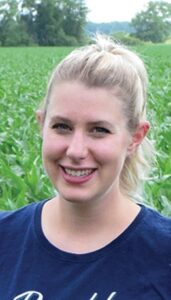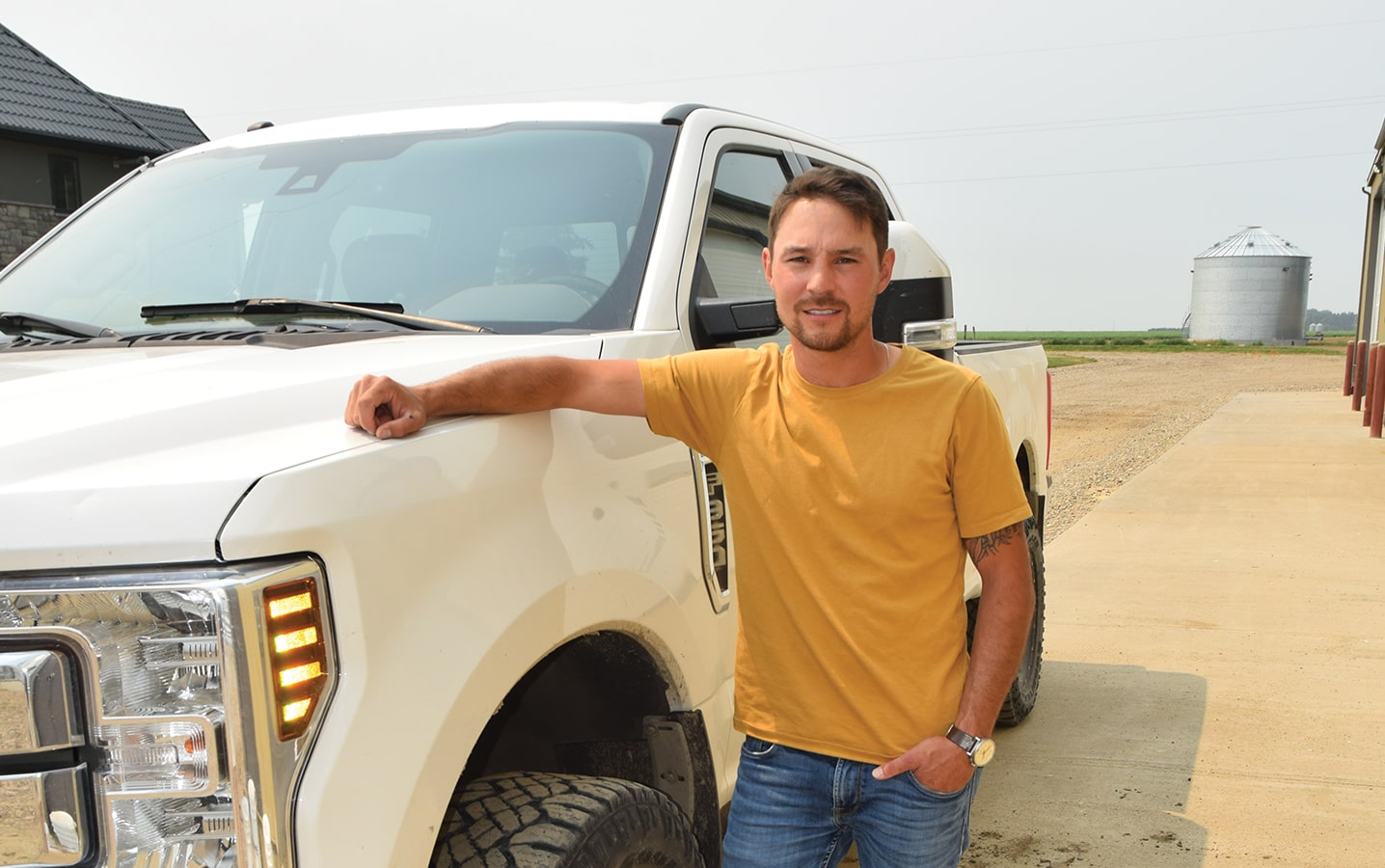Excited or nervous?
 Lyndon Nakamura
Lyndon Nakamura
Taber, Alberta
“Producers are already good stewards of the climate and the land, and regenerative agriculture methods have been around for a long time already, but consumers and government mandates will continue to push us to net more with less.”
Lyndon Nakamura sees a strong emphasis on protecting the environment. “Producers are already good stewards of the climate and the land, and regenerative agriculture methods have been around for a long time already,” he says, “but consumers and government mandates will continue to push us to net more with less.”
One way farmers can do more with less, Nakamura says, is with telemetry tools that monitor different weather patterns, disease pressures and crop health. For example, temperature, soil moisture and humidity data from in-field weather stations and soil probes can be plugged into models to determine if and when to spray to protect canola from sclerotinia stem rot. These tools can also help Nakamura Farms make better decisions on when to irrigate and how much water the crop really needs, which will save water and improve water use efficiency.
Nakamura identifies one other positive trend, which is more direct farm marketing to local consumers through on-farm stores, in-house butcher shops and value-added businesses.
A trend that has him nervous is the labour shortage in agriculture. “I think it will become much harder to find skilled drivers and operators moving forward,” he says.
“I am also a little nervous that there will be fewer students enrolling into agriculture-based programs that train our scientists, agronomists and veterinarians.”
Overall, Nakamura has a positive outlook. “Agriculture is an exciting sector to be a part of and I look forward to what the future brings to the industry.”
 Leonard Waldner
Leonard Waldner
Lauder, Manitoba
Leonard Waldner is nervous about the current price and supply situation for fertilizer, seed and feed grains. “These grain prices are a good thing – as long as you don’t have to buy feed.”
Leonard Waldner is nervous about the current price and supply situation for fertilizer, seed and feed grains. Waldner is the farm manager at Maple Grove Colony, which has just under 4,000 acres of crop land, an isowean hog operation with 1,100 sows and 8,000 laying hens. They grow corn, wheat and soybeans for feed (although drought and heat reduced their 2021 yields), so they have some in-house supply but the “cost” to the business of using that supply represents the price they could get if they sold it. They also buy barley for hog feed because “barley burns off in their hot sandy soil,” he says. As of November, prices are $9 per bushel for feed barley, $9 for corn and $11-$12 for feed wheat. “These grain prices are a good thing – as long as you don’t have to buy feed,” he says.
In planning for 2022 crop, Waldner says fertilizer quotes as of November are four times what he paid last year. “An option,” he says, “is to reduce yield targets and make use of whatever is in the ground.” After lower yields due to drought, soil reserves should be higher than usual. The farm produces manure from the poultry and hog operations, but not enough to supply all acres. “We get maybe enough for one section of land per year,” Waldner says. About one-third of acres each year are in soybeans, which do not get any nitrogen fertilizer. All in all, the farm has some options but input costs are a concern for Waldner.
One bit of good news is that he ordered canola seed early, so he thinks he should be able to get the supply he needs.
 Roland Crowe
Roland Crowe
Piapot First Nation, Saskatchewan
“By farming better, we can make more money from the same land and become more environmentally committed.”
Roland Crowe is excited about the new canola processing facilities at Regina and what that will mean for canola growers. “Farmers
will have more marketing options and less cost in transportation,” he says.
One troubling trend for Crowe is the continuing drop in rural farm populations. He’d like to see farms get better instead of bigger, which could slow the population trend and help the environment at the same time. “By farming better, we can make more money from the same land and become more environmentally committed,” he says.
“I’m trying to farm better myself,” says Crowe, who is 79. This includes steps to make crops more competitive, like shallow seeding so the crop comes up ahead of the weeds.
Crowe also wants to look into programs that make it easier for him and other Indigenous farmers to access input capital. Reserve land cannot be used as collateral, which makes it more difficult for Indigenous farmers to access operating funds. “If inputs are $200 or more per acre and an Indigenous farmer has 300 acres, who has that kind of cash needed to buy seed, fertilizer and other inputs needed to grow crops?” he says. Yet, the opportunity is there to make a return. “At current durum prices, we could make $500 or $600 per acre if we do things right.”
 Brett Jans
Brett Jans
New Norway, Alberta
“As the price of inputs, equipment and land rent and value skyrockets, the initiative to improve the soil that you own is increasing.”
Brett Jans is excited about the new interest in ways to improve soil health with diverse rotations and soil amendments. “As the price of inputs, equipment, and land rent and value skyrockets, this is the initiative to improve the soil that we own,” he says. This also brings the “very exciting new sector” of beneficial biological products like humic acid, fulvic acid and improved nitrogen-fixing bacteria. “The only downside,” he says, “is that these products are in a buyer-beware
market with no regulation on how effective they are or at what rate is required to get the results you’re looking for.”
Jans would also like to see field-scale multi-year data on the use of lime and gypsum to improve soil pH in acidic soils and to mitigate high magnesium and high sodium soils with gypsum.
As for things that make him nervous, Jans is concerned over the new trend in regenerative agriculture. “I will honestly say I know nothing about regenerative agriculture,” Jans says. He thinks that commitments by major food companies to contract grain from “regenerative” acres might be premature. “Is regenerative agriculture scientifically proven to be a sustainable practice that will improve carbon sequestration while also being efficient and economically viable for farmers?” Jans says. “Regenerative agriculture may be fantastic or perhaps we are already practicing it on our farm with a four-year rotation,
designated wetlands and avoiding tillage when possible.” But he has not seen a checklist that designates farm practices as regenerative or not.
“As a farmer, I recognize a need to change and improve,” he says. “I just want to make sure I’m doing things that make a real difference.”
 Nicolea Dow
Nicolea Dow
Portage la Prairie, Manitoba
“We need to stop using a flat rate of fertilizer for the whole farm, for economic and environmental benefits, but if we want to increase production, we can’t have a flat reduction in fertilizer. Instead, we need to increase efficiencies and decreases losses.”
For Nicolea Dow, climate change policy is her answer to both questions. She’s eager to see how Canada’s agriculture system can adapt to the global need for action, but she’s also a bit nervous about how farmers will join in the process.
“When I was at university doing my agriculture degree 10 years ago, we wished urban people cared more about agriculture,” Dow says. That isn’t an issue now. “In the past 10 years, people have become more concerned about their food and where it comes from. This is exciting for me.”
Dow finds it exciting because she has a long-term outlook and thinks her on-farm practices will align with concerned consumers. Even though farmers may not “speak the same language” as policy makers and consumers, they care about the same things, Dow says.
“As a generational farmer, I have to take care of the land.
I am willing to plant unproductive acres into forages and to plant more trees and take steps to improve soil health and maximize fertilizer efficiency,” she says. “It is ingrained in farmers that we do these things to take care of the land, and these actions present a real opportunity for agriculture.”
What makes her nervous is that farmers are not seen as experts when it comes to these land stewardship measures. “Farmers want to change. We want to adapt. That is why we invest in research,” she says. “Policy makers need to know that farmers already do an excellent job at being sustainable and that farmers are always ready to improve – but we need the research that demonstrates the best ways to adapt and change. I worry that policy is running ahead of proven practice.”
 Codie Nagy
Codie Nagy
Ogema, Saskatchewan
“In the past 10 years, people have become more concerned about their food and where it comes from. This is exciting for me.”
Codie Nagy likes that Canadian agriculture is having a conversation about nutrient use efficiency, especially for nitrogen. “We need to get more efficient and we need to drive innovation,” he says. “Farmers are already doing a good job, but we need a nudge to do better.”
When asked what he would do better, Nagy says he’d like to see rates that are more in-tune with what each field and each crop needs. That could include analyzing grain to see how much nutrient was removed at harvest, and apply fertilizer at rates that match removal for each field. He’d also like to use variable-rate technology to use rates that align with the yield potential of zones within fields. “In general, farmers definitely need to stop using a flat rate of fertilizer for the whole farm,” he says.
Biologicals like Utrisha N from Corteva and Envita from Azotic are “intriguing,” he says. “Those are the kinds of innovations that get me excited.” He also sees a lot of potential in wide-scale adoption of 4R to improve nutrient use efficiency. He’d rather see farmers come forward with a 4R-based plan that will satisfy the need to reduce nitrogen losses to the air and water, rather than have government policy dictate what farmers need to do.
What makes him nervous is a policy that would call for a flat reduction in nitrogen fertilizer supply. “We need to stop using a flat rate of fertilizer for the whole farm, for economic and environmental benefits, but if we want to increase production, we can’t have a flat reduction in fertilizer,” he says. “Instead, we need to increase efficiencies and decreases losses.”





